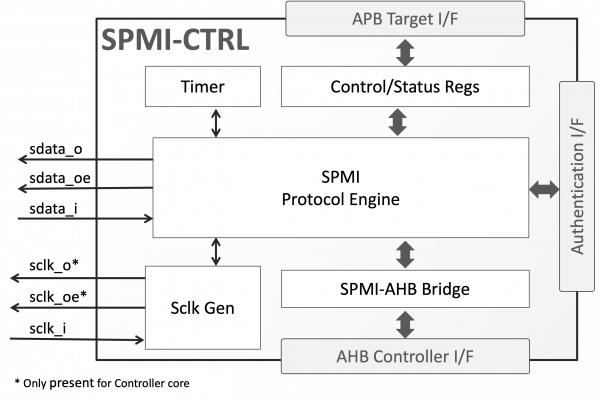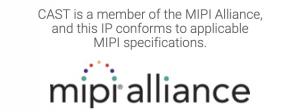Silicon IP Cores
SPMI-CTRL
MIPI SPMI Controller or Target
The SPMI-CTRL core implements a highly featured, easy-to-use controller for the MIPI System Power Management Interface (MIPI-SPMI) bus. It supports the latest version (v2.0) of the MIPI-SPMI specification, and is suitable for the implementation of either controller or target nodes in an SPMI bus.
The core is designed to minimize the software load on the host processor. Once configured, the core requires no assistance from the host to initialize the bus, connect to bus or disconnect from the bus, grant access of the bus, execute incoming SPMI commands, generate ACK/NACK responses, and check address and data parity.
Although the core only expects the host to provide the outgoing SPMI commands, it provides thorough status information to the host, which can be used for a higher application layer or for debugging purposes. Last received command, outgoing command status, bus status, and node operation status are made available to the host via the core’s registers. Parity errors, unknown commands, or failure of receiving node to provide ACK/NACK response are also reported. Furthermore, the core can be programmed to operate in debug mode, under which the core captures and reports all SPMI bus commands regardless of the destination address.
Integration of the core is extremely simple: The core provides access to its registers via a AMBA™ 2 APB target interface, and converts the incoming SPMI read/write commands to accesses on its AHB controller port. This SPMI-AHB bridging allows easy mapping of the SPMI address space to shared memories or peripheral registers. A dedicated interface allows integration with application specific authentication logic, which can be reduced to just hardwiring the authentication response data. The core uses separate clocks for its APB and AHB bus interfaces, and a separate reference clock source for its internal timer. Clocks are independent to each other, with clean clock domain crossing boundaries, and the only requirement is that the AMBA interface clocks have a frequency larger or equal to the maximum SPMI clock frequency.
The core is designed with industry best practices, and its reliability has been proven through rigorous verification.
The SPMI-CTRL can be mapped to any ASIC technology or FPGA device. The following table provides sample performance and resource utilization data. Please contact CAST to get characterization data for your target configuration and technology.
| Configuration | Technology | Area | Max. Serial Clock |
|---|---|---|---|
| Arbitration-Capable Master | TSMC 28nm HPC< | 5,740 eq. Gates | 26 MHz |
| Request-Capable Slave | TSMC 28nm HPC | 5,450 eq. Gates | 26 MHz |
The SPMI-CTRL can be mapped to any AMD FPGA device, provided sufficient resources are available. The following table provides sample performance and resource utilization data. Please contact CAST to get characterization data for your target device and technology
| Configuration | Device Family | Logic Resources | Max. Serial Clock |
|---|---|---|---|
| Arbitration-Capable Master | Spartan-7, Artix-7, Kintex-7 | 880 LUTs | 26 MHz |
| Arbitration-Capable Master | Kintex & Virtex Ultrascale | 830 LUTs | 26 MHz |
| Request-Capable Slave | Spartan-7, Artix-7, Kintex-7 | 750 LUTs | 26 MHz |
| Request-Capable Slave | Kintex & Virtex Ultrascal | 690 LUTs | 26 MHz |
The SPMI-CTRL can be mapped to any Intel® FPGA device. The following table provides sample performance and resource utilization data. Please contact CAST to get characterization data for your target device and technology.
| Configuration | Device Family | Logic Resources | Max. Serial Clock |
|---|---|---|---|
| Arbitration-Capable Master | Max® 10 | 1,870 LEs | 26 MHz |
| Arbitration-Capable Master | Startix® 10, Arria® 10 | 860 ALMs | 26 MHz |
| Request-Capable Slave | Max® 10 | 2,160 LEs | 26 MHz |
| Request-Capable Slave | Startix® 10, Arria® 10 | 1,065 ALMs | 26 MHz |
The SPMI-CTRL can be mapped to any Lattice FPGA device, provided sufficient resources are available. The following table provides sample performance and resource utilization data. Please contact CAST to get characterization data for your target device and technology
| Configuration | Device Family | Logic Resources | Max. Serial Clock |
|---|---|---|---|
| Non-Arbitration-Capable Master | ECP5 | 1,269 LUT4s / 646 Slices | 26 MHz |
| Request-Capable Slave | ECP5 | 2,556 LUT4s / 1,296 Slices | 26 MHz |
| Non-Request-Capable Slave | ECP5 | 1,188 LUT4s / 610 Slices | 26 MHz |
| Arbitration-Capable Master | MachXO2 | 2,724 LUT4s / 1,375 Slices | 26 MHz |
| Non-Arbitration-Capable Master | MachXO2 | 1,274 LUT4s / 644 Slices | 26 MHz |
| Arbitration-Capable Master | iCE40 HX | 3,237 LUTs / 3,247 LCs | 26 MHz |
| Non-Arbitration-Capable Master | iCE40 HX | 1,474 LUTs / 1,477 LCs | 26 MHz |
| Request-Capable Slave | iCE40 HX | 2,893 LUTs / 2,808 LCs | 26 MHz |
| Non-Request-Capable Slave | iCE40 HX | 1,346 LUTs / 1,346 LCs | 26 MHz |
The SPMI-CTRL can be mapped to any Microchip FPGA device, provided sufficient resources are available. The following table provides sample performance and resource utilization data. Please contact CAST to get characterization data for your target device and technology
| Configuration | Device Family | Logic Resources | Max. Serial Clock |
|---|---|---|---|
| Arbitration-Capable Master | PolarFile | 2,727 4LUTs / 805 DFFs | 26 MHz |
| Non-Arbitration-Capable Master | PolarFile | 1,331 4LUTs / 464 DFFs | 26 MHz |
| Request-Capable Slave | PolarFile | 2,711 4LUTs / 750 DFFs | 26 MHz |
| Non-Request-Capable Slave | PolarFile | 1,237 4LUTs / 367 DFFs | 26 MHz |
| Arbitration-Capable Master | IGLOO2 | 2,805 4LUTs / 805 DFFs | 26 MHz |
| Non-Arbitration-Capable Master | IGLOO2 | 1,345 4LUTs / 464 DFFs | 26 MHz |
| Request-Capable Slave | IGLOO2 | 2,721 4LUTs / 750 DFFs | 26 MHz |
| Non-Request-Capable Slave | IGLOO2 | 1,222 4LUTs / 367 DFFs | 26 MHz |
| Arbitration-Capable Master | ProASIC3 | 5,332 CORE / 808 SEQ | 26 MHz |
| Non-Arbitration-Capable Master | ProASIC3 | 2,658 CORE / 468 SEQ | 26 MHz |
| Request-Capable Slave | ProASIC3 | 4,939 CORE / 809 SEQ | 26 MHz |
| Non-Request-Capable Slave | ProASIC3 | 2,444 CORE / 395 SEQ | 26 MHz |
Engineered by Silesia Devices.
Features List
MIPI-SPMI v2.0 Controller or Target
- Supports High Speed (HS) and Low Speed (LS) device classes
- Serial clock frequencies from 32kHz to 26MHz
- Supports all commands, including Block, Extended and Extended Long Read/Writes
- Supports all arbitration levels. Suitable for multi-controller and/or multi-target busses.
- Configurations:
- Arbitration-Capable Controller
- Non-Arbitration-Capable Controller
- Request-Capable Target
- Non-Request-Capable Target
Low Host Overhead
- Autonomously performs bus initialization, bus connect/disconnect, and bus arbitration
- Autonomously executes all incoming SPMI commands, and generates ACK/NACK responses
- Host is only required to: a) initialize register values after a reset b) define outgoing commands and arbitration levels and c) optionally respond to reported errors
Run-time Debugging Features
- Broadcasts SPMI bus state and device state
- Detects and reports parity, bus or command errors
- Under debug mode captures all traffic in the SPMI bus
- Run-time programmable identifiers (Controller, Target and up to 6 Group Target Identifiers per device)
Easy Integration
- Directly bridges SPMI and AHB bus address space, allowing SPMI address space mapping either to a shared memory or directly to peripheral registers
- Register access via 32-bit AMBA™ 2 APB bus
Small and Low Power
- Less than 6,000 Gates for either the controller or the target core
- Direct serial clock usage to minimize switching activity when idle



